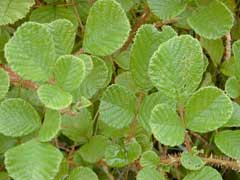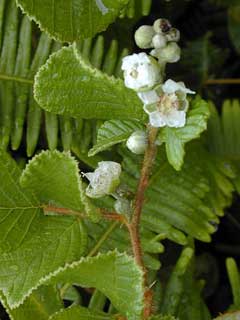 |
|
http://www.hear.org/starr/ |
 |
| http://www.hear.org/starr/ |
Translate this page:
Summary
Physical Characteristics

 Rubus ellipticus is an evergreen Shrub growing to 4.5 m (14ft 9in).
Rubus ellipticus is an evergreen Shrub growing to 4.5 m (14ft 9in).
See above for USDA hardiness. It is hardy to UK zone 8. It is in leaf all year. The species is hermaphrodite (has both male and female organs) and is pollinated by Insects.
Suitable for: light (sandy), medium (loamy) and heavy (clay) soils and prefers well-drained soil. Suitable pH: mildly acid, neutral and basic (mildly alkaline) soils. It can grow in semi-shade (light woodland) or no shade. It prefers moist soil.
UK Hardiness Map
US Hardiness Map
Synonyms
Plant Habitats
Woodland Garden Sunny Edge; Dappled Shade;
Edible Uses
Edible Parts: Fruit
Edible Uses:
Fruit - raw or cooked[[46, 51, 183, 272]. A good raspberry-like flavour[146, 158, 183]. Sweet with a pleasant blend of acidity[194]. he golden yellow fruit is about 10mm in diameter[266]. Annual yields from wild plants in the Himalayas are about 750g from a plant occupying 2.5m²[194]. The fruit contains about 10.9% sugars, 1.1% protein, 0.5% ash, 0.55 pectin[194].
References More on Edible Uses
Medicinal Uses
Plants For A Future can not take any responsibility for any adverse effects from the use of plants. Always seek advice from a professional before using a plant medicinally.
Astringent Dysentery Febrifuge Kidney Miscellany Stomachic
The plant is astringent and febrifuge[272]. A decoction of the root, combined with Girardinia diversifolia root and the bark of Lagerstroemia parviflora, is used in the treatment of fevers[272]. The juice of the root is used in the treatment of fevers, gastric troubles, diarrhoea and dysentery[272]. A paste of the roots is applied externally to wounds[272]. Both the roots and the young shoots are considered to be a good treatment for colic[272]. The leaf buds, combined with Centella asiatica and Cynodon dactylon, are pounded to a juice and used in the treatment of peptic ulcers[272]. The juice of the fruit is used in the treatment of fever, colic, coughs and sore throat[272]. The inner bark is used in Tibetan medicine, it is said to have a sweet and sour flavour plus a heating potency[241]. A renal tonic and antidiuretic, it is used in the treatment of weakening of the senses, vaginal/seminal discharge, polyuria and micturation during sleep[241].
References More on Medicinal Uses
The Bookshop: Edible Plant Books
Our Latest books on Perennial Plants For Food Forests and Permaculture Gardens in paperback or digital formats.

Edible Tropical Plants
Food Forest Plants for Hotter Conditions: 250+ Plants For Tropical Food Forests & Permaculture Gardens.
More

Edible Temperate Plants
Plants for Your Food Forest: 500 Plants for Temperate Food Forests & Permaculture Gardens.
More

More Books
PFAF have eight books available in paperback and digital formats. Browse the shop for more information.
Shop Now
Other Uses
Dye Miscellany Soil stabilization
A purple to dull blue dye is obtained from the fruit[168]. The plant is grown to deter soil erosion and is good for soil conservation[272].
Special Uses
References More on Other Uses
Cultivation details
Easily grown in a good well-drained loamy soil in sun or semi-shade[1, 11, 200]. This species is not very hardy in Britain, but it tolerates some frost and should succeed outdoors in the south and west of the country[200]. Cultivated for its edible fruit in southern U.S.A[46]. The fruit is sold in local markets in the Himalayas[194, 272]. This species has become established and naturalized in some areas of the Andes in S. America, where it is looking as though it could become a serious weed problem. This species is a raspberry with biennial stems, it produces a number of new stems each year from the perennial rootstock, these stems fruit in their second year and then die[200]. Plants in this genus are notably susceptible to honey fungus[200].
References Carbon Farming Information and Carbon Sequestration Information
Temperature Converter
Type a value in the Celsius field to convert the value to Fahrenheit:
Fahrenheit:
The PFAF Bookshop
Plants For A Future have a number of books available in paperback and digital form. Book titles include Edible Plants, Edible Perennials, Edible Trees,Edible Shrubs, Woodland Gardening, and Temperate Food Forest Plants. Our new book is Food Forest Plants For Hotter Conditions (Tropical and Sub-Tropical).
Shop Now
Plant Propagation
Seed - requires stratification and is best sown in early autumn in a cold frame. Stored seed requires one month stratification at about 3°c and is best sown as early as possible in the year. Prick out the seedlings when they are large enough to handle and grow on in a cold frame. Plant them out into their permanent positions in late spring of the following year. Cuttings of half-ripe wood, July/August in a frame[200]. Tip layering in July. Plant out in autumn. Division in early spring or just before leaf-fall in the autumn[200].
Other Names
If available other names are mentioned here
Aakhre, Aingkushi, Ainselu, Akhe, Akhi, Akhre, Anchhu, Arbei kuning himalaya, Aselu, Batnak, Borjetulipoka, Bunut, Butnak, Cheemullu, Chyaga, Esar, Gouriphal, Hinsalu, Hinsar, Hinure, Hisalu, Hisara, Hishalu, Hmu-tau, Jilyung, Jogiya hisalu, Jotelupoka, Jotelupoka, Kimrupsiang, Leole, Lingsan, Ngushi, Nintcho, Rato aiselu, Shaga, Shiinghoshi, Soh-pero, Subwe, Sumwe, Theimi, Thulo aselu, Titau, Tolu, Tuo yuan xuan gou zi, Yellow raspberry,
Native Range
TEMPERATE ASIA: China (Guangxi Zhuangzu Zizhiqu, Guizhou Sheng, Sichuan Sheng, Xizang Zizhiqu (south), Yunnan Sheng) TROPICAL ASIA: Bhutan, India, Sri Lanka, Nepal, Pakistan, Myanmar, Thailand (north), Vietnam, Philippines (Luzon)
Weed Potential
Right plant wrong place. We are currently updating this section.
Please note that a plant may be invasive in one area but may not in your area so it's worth checking.
Conservation Status
IUCN Red List of Threatened Plants Status :

Growth: S = slow M = medium F = fast. Soil: L = light (sandy) M = medium H = heavy (clay). pH: A = acid N = neutral B = basic (alkaline). Shade: F = full shade S = semi-shade N = no shade. Moisture: D = dry M = Moist We = wet Wa = water.
Now available:
Food Forest Plants for Mediterranean Conditions
350+ Perennial Plants For Mediterranean and Drier Food Forests and Permaculture Gardens.
[Paperback and eBook]
This is the third in Plants For A Future's series of plant guides for food forests tailored to
specific climate zones. Following volumes on temperate and tropical ecosystems, this book focuses
on species suited to Mediterranean conditions—regions with hot, dry summers and cool, wet winters,
often facing the added challenge of climate change.
Read More
Expert comment
Author
Sm.
Botanical References
51200266
Links / References
For a list of references used on this page please go here
Readers comment